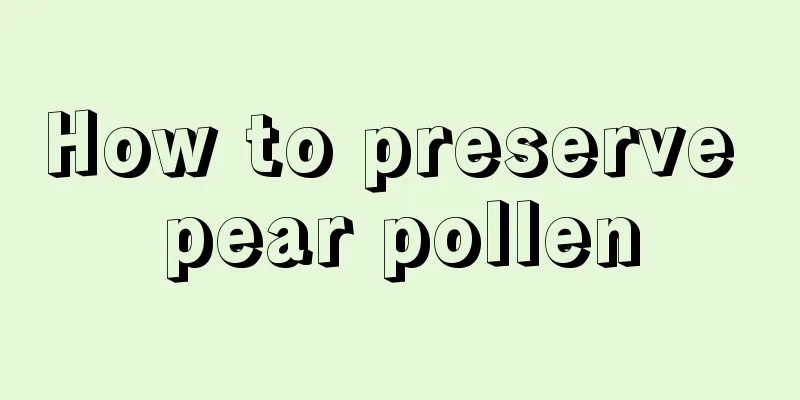How to preserve pear pollen

|
Pollen mainly comes from a substance in the stamens. Each kind of flower has a different kind of pollen. Different pollens have their own nutritional value and trace elements. Pear pollen is also a relatively common kind. Pear pollen also needs to be picked and pollinated. Pear pollen also contains certain nutrients, which is very good for the body. The storage of pear pollen is also very important. It needs to be stored in a dry and ventilated place. How to store pear pollen? When processing pollen, the temperature should not exceed 24 degrees. It can be stored for 7 days at room temperature (but 5 days is best), and for more than 20 days at 0 degrees. Pear is a self-incompatible fruit tree. Most varieties cannot bear fruit through self-pollination and rely on distant hybridization to reproduce. In production, suitable pollination trees and cultivars are configured for cross-pollination to improve fruit set. Pear pollen is mainly transmitted through breezes, bees and insects. Artificial assisted pollination technology is often used in the pear production process to increase the fruit setting rate and ensure yield and quality. The amount and quality of pollen in the pollinated variety directly affect the fruit setting rate, yield and quality of the main cultivated varieties. The main cultivated varieties and pollination varieties need to pollinate each other to ensure yield and economic benefits. Pear trees also need artificial pollination in the following aspects during cultivation: 1. Single cultivar; 2. The main varieties and pollination varieties do not bloom at the right time. There are two reasons for this: ① The main planting variety and the pollination variety are not well matched, and the flowering periods are far apart; 3. When there are adverse weather conditions during the flowering period, such as strong winds, dry and hot sandstorms, many days of rain, low temperatures during the flowering period, frost, etc., the activities of honey insects such as honey bees will be affected, which will lead to poor pollination, reduce the fruit setting rate, or cause flowers to bloom without fruits. There are two main methods for producing pollen in conventional artificial pollination: (1) Artificial pollination: Hold a flower in each hand, rub the flower centers against each other, and rub the anthers, filaments, and petals onto paper. Remove the petals and filaments, spread the anthers thinly on the paper, and place them in a room at about 25°C to dry. It usually takes 28-48 hours for the anthers to crack and release pollen. (2) Pollen extraction machine: Use an anther extractor to extract the anthers, sieve out the petals, pedicels and other debris, then spread the anthers thinly on a smooth white paper, place in a greenhouse at 23-25°C and dry in the shade for 28-40 hours, then the pollen will be released in large quantities. It usually takes 2-3 days to complete the production of pollen using the above method. The above method solves the problem of artificial pollination of pear trees under normal circumstances, but for special circumstances such as abnormal weather and improper matching of pollination varieties, for example, when the main cultivated variety is in its initial flowering period when the pollination variety is in full bloom, or when the main cultivated variety is in full bloom when the pollination variety is in its initial flowering period, and it usually takes 2-3 days to make pollen, this will result in a reduction in yield of the variety that blooms first due to untimely pollen production and lack of artificial pollination. In pear cultivation, the pollination variety that blooms first is also one of the main cultivated varieties (generally the ratio of pollination variety to cultivated variety is 1:4, and some are as high as 1:1). The yield of the pollination variety is particularly important for the total yield of pear cultivation. The results of the study showed that under dry conditions, the lower the storage temperature, the slower the decline in pollen vitality and the longer the storage period. Fengshui pear pollen can maintain its vitality for a long period of time at -73°C and -196°C. Generally, pear pollen with a germination rate of over 55% is considered high-quality pollen, and the pollen germination rate after 540 days of ultra-low temperature storage is over 60%, which can meet the requirements of pollination in production. However, preserving pollen through this method is costly and requires high professional skills from the preservation personnel. Currently, this technology is in the scientific research stage and it is difficult for ordinary farmers and companies to master and use it. |
<<: How to store sparkling wine
>>: Can I use moxa during menstruation?
Recommend
How long does it usually take to conceive and implant after having sex
Many couples who want to get pregnant and have ch...
What are the symptoms of thyroid cancer? Early detection and early treatment
What are the symptoms of thyroid cancer? Early de...
What to do if my stomach is bloated and painful
Abdominal bloating and pain is a common symptom, ...
What is aortic valve calcification?
Aortic valve calcification is actually a congenit...
What is epididymitis
Epididymitis is a common disease in men. Most men...
Hemangioma in the abdomen
If people often eat foods that increase blood con...
Is it good to eat more dried shrimps? Why?
Everyone knows that dried shrimps are very rich i...
What happens to the legs when growing taller
Whether men or women, they all want to have a pai...
Very few people know the correct treatment for metastatic lung cancer!
Metastatic lung cancer is a symptom caused by the...
What causes bone cancer
What causes bone cancer? Bone tumors are a diseas...
Psychological analysis of people with strong control desire
In daily life, it is very common to see people wi...
Calories in chewing gum
Many people have eaten chewing gum. The calories ...
What to do if a patient with endometrial cancer becomes pregnant
Pregnancy and childbirth are sacred and great thi...
This is more painful than childbirth
We all know that childbirth is extremely painful....
3 kinds of therapeutic soups for laryngeal cancer
The throat is the only way for us to breathe norm...









